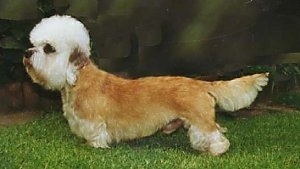Daphne the Dandie Dinmont at 3 years old (Pitfirrane breeding) and Madge the Dandie Dinmont puppy at 12 weeks (Hendell breeding)
Dan-die Din-mont Ter-ee-er 
The Dandie Dinmont Terrier is a low to the ground, longer than he is tall, little dog. The large head has a topknot that is in proportion to the body. The skull is broad between the ears, gradually tapering to the eyes. The muzzle is deep, with a well-defined stop. The large teeth meet in a scissors bite. The moderately large nose and the lips are dark in color. The large, round, wide-set eyes come in dark hazel with dark eye rims. The 3 to 4 inch (7-10 cm) ears are pendant, set low and wide, hanging close to the cheeks. The legs are short with the back legs being a little longer than the front legs. The "scimitar" tail looks like a curved sword and is about 8 to 10 inches (20-25 cm) long, thicker for about 4 inches then tapering to a point. Dewclaws may be removed when puppies are three or four days old. The coat is about 2 inches (5 cm) long, with a mix of soft and hard hairs. Hair on the underside is softer in texture and the head is covered with an even softer, silky topknot. Coat colors come in pepper (dark bluish black to a light silvery gray) or mustard (reddish brown to a pale fawn). Mustard puppies are born with a dark brown coat which lightens into varying shades of red when it reaches an adult. Pepper puppies are born black and tan that silvers later in life. Pepper coats have a silver topknot and mustard color coats have a cream-colored topknot.
The Dandie Dinmont makes a great companion dog, affectionate and happy-go-lucky. It is lively, bold, brave, independent and intelligent. Because of this terrier's hunting instincts, it should not be trusted with non-canine pets, such as hamsters, rabbits, pet mice and guinea pigs. It will be okay with cats that it is raised with from puppyhood. They are not difficult to train, if you are firm and consistent. Makes a good watchdog, but needs to be told, after getting your attention with the first warning bark, it is time to be quiet and let you handle the rest. Because of this breed’s small size, a lot of Dandie Dinmont Terriers develop Small Dog Syndrome, human induced behaviors where the dog believes he is king of the home. Dogs with small dog syndrome are led to believe they own the humans and everything else around them, and do their best to keep and defend what they own. This causes many varying degrees of behavior issues, including, but not limited to, stubbornness, determination, willful, guarding, separation anxiety, difficulty with obedience training, reserved with strangers, snapping, biting, dog-aggressiveness, and obsessive barking, as the dog tries to keep his humans and everyone else around him in line. These are NOT Dandie Dinmont traits, but behaviors brought on by the lack of a firm, consistent pack leader who provides rules and limits to what it is and is not allowed to do, along with the lack of a daily pack walk. As soon as the humans take the control away from the dog, and the dog's instincts are met, the negative behaviors will begin to subside and the Dandie Dinmont will be a wonderful, trustworthy family companion.
Height: 8 - 11 inches (20 - 28 cm)
Weight: 18 - 24 pounds (8 - 11 kg)
Generally a healthy breed. Some are prone to glaucoma and epilepsy. Hypothyroidism can occur when the dog is older. Do not overfeed, as an overweight dog can have back problems.
The Dandie Dinmont Terrier is good for apartment life. They are fairly active indoors and a small yard will do as long as you take them for daily walks. Likes to chase, be careful when taking them off the leash.
Dandie Dinmonts need to be walked daily. They will also enjoy sessions of play in the park or other safe open areas.
About 12-15 years
About 3 to 6 puppies
The Dandie Dinmont needs to be brushed regularly. They should have professional grooming. Dead hair should be plucked out once or twice a year. Show dogs require much more grooming. This breed sheds little to no hair.
The Dandie Dinmont is an old terrier dating back to the 1700s, originating from the border area between England and Scotland. The breed may have been developed from the Skye Terrier and the now extinct Scotch Terrier (not to be confused with today's Scottish Terrier). The breed was popular among the gypsies and was used by farmers to kill vermin. With its short legs it was able to go to ground hunting badgers and otter. In 1814 Sir Walter Scott wrote about the breed in his famous novel "Guy Mannering." In the book there was a character named Dandie Dinmont, and that is where the breed got its name. It was recognized by the AKC in 1886. Some of the Dandie Dinmont's talents are vermin catcher, hunting rabbit, otter, badger, martens, weasels and skunks.
Terrier, AKC Terrier
Daphne the Dandie Dinmont at 3 years old (Pitfirrane breeding) and Madge the Dandie Dinmont puppy at 12 weeks (Hendell breeding)
Daphne the Dandie Dinmont at 3 years old (Pitfirrane breeding) and Madge the Dandie Dinmont puppy at 12 weeks (Hendell breeding)
Daphne the Dandie Dinmont at 3 years old
Madge the Dandie Dinmont puppy at 12 weeks
Madge the Dandie Dinmont puppy at 12 weeks
Longfellow the Dandie Dinmont Terrier licking his chops
Longfellow the Dandie Dinmont Terrier taking a nap on the chair

This is CH German Dandies' Earl of Speedy. Photo courtesy of DandieOnline
Buddy the Dandie Dinmont Terrier at 9 years old with a puppy cut—"He has a great personality, and I've never heard him bark except for when he's sleeping (dreaming) :)"